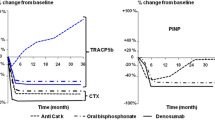Abstract
Urinary excretion of cross-linked N-telopeptide of type I collagen (NTX) has been reported to be a specific indicator of bone resorption. We studied the utility of a new immunoassay for NTX as an indicator of changes in bone resorption caused by treatment with pamidronate (APD) followed by T3. Twenty-two male subjects received either placebo (Group 1) or APD on study days 1–2 (Group 2). One week later all subjects received T3 100 μg/day (days 8–15). Urinary NTX, pyridinoline (PYD), hydroxyproline (HYP), and creatinine (cr) were measured on 2-hour fasting urine samples at baseline (day 1), after APD/placebo (day 8), after T3 (day 16), and at days 30 and 58. NTX/cr excretion fell 85% after treatment with APD (P<0.001 versus baseline), but not after placebo. The fall in mean urinary NTX after receiving APD was greater than the fall in PYD (25%) or HYP (31%) (P<0.001 NTX versus PYD and HYP). After treatment with APD, NTX excretion remained suppressed below baseline until day 58, whereas PYD and HYP excretion returned to baseline by study day 16. Persistence of APD's effect on bone until day 58 was suggested by the fact that serum calcium and parathyroid hormone levels had not returned to baseline by day 58. On day 16, after all subjects were treated with T3, urinary NTX/cr rose significantly (P<0.01) in Group 1 (-bisphosphonate) but not in Group 2 (+bisphosphonate). We conclude that urinary NTX is responsive to acute thyroid hormone-induced increases and bisphosphonate-induced decreases in bone resorption, and may reflect these changes more accurately than PYD or HYP.
Similar content being viewed by others
References
Delmas PD, Schlemmer A, Gineyts E, Riis B, Christiansen C (1991) Urinary excretion of pyridinoline crosslinks correlates with bone turnover measured on iliac crest biopsy in patients with vertebral osteoporosis. J Bone Miner Res 6:639–644
Seibel MK, Gartenberg F, Silverberg SJ, Ratcliffe A, Robins SP, Bilezikian JP (1992) Urinary hydroxypyridinium cross-links of collagen in primary hyperparathyroidism. J Clin Endocrinol Metab 74:481–486
McLaren AM, Hordon LD, Bird HA, Robins SP (1992) Urinary excretion of pyridinium crosslinks of collagen in patients with osteoporosis and the effects of bone fracture. Ann Rheum Dis 51:648–651
Body JJ, Delmas PD (1992) Urinary pyridinium cross-links as markers of bone resorption in tumor-associated hypercalcemia. J Clin Endocrinol Metab 74:471–475
Uebelhart D, Schlemmer A, Johansen JS, Gineyts E, Christiansen C, Delmas PD (1991) Effect of menopause and hormone replacement therapy on the urinary excretion of pyridinium cross-links. J Clin Endocrinol Metab 72:367–373
Ohishi T, Takahashi M, Kushida K, Horiuchi K, Ishigaki S, Inoue T (1992) Quantitative analyses of urinary pyridinoline and deoxypyridinoline excretion in patients with hyperthyrodism. Endocr Res 18:281–290
Robins SP, Black D, Paterson CR, Reid DM, Duncan A, Seibel MJ (1991) Evaluation of urinary hydroxypyridiníum crosslínk measurements as resorption markers in metabolic bone diseases. Eur J Clin Invest 21:310–315
Taylor AK, Arnaud S, Barr B, Lueken S, Bettica P, Baylink D (1992) Urine pyridinium crosslinks correlate better with serum osteocalcin than with other bone resorption markers during a prospective bedrest study (abstract). J Bone Miner Res 7:S244
Seyedin SM, Kung VT, Daniloff YN, Hesley RP, Gomez B, Nielsen LA, Rosen HN, Zuk RF (1993) Immunoassay for urinary pyridinoline: the new marker of bone resorption. J Bone Miner Res 8:635–641
Eyre D (1992) New biomarkers of bone resorption (editorial). J Clin Endocrinol Metab 74:470A-470C
Hanson DA, Weis ME, Bollen A-M, Maslan SL, Singer FR, Eyre DR (1992) A specific immunoassay for monitoring human bone resorption: quantitation of type I collagen cross-linked N-telopeptides in urine. J Bone Miner Res 7:1251–1258
Eyre DR, Gertz BJ, Shao P, Hanson DA, Harris ST, Genant HK, Chesnut CH III (1992) Monitoring bone resorption in early post-menopausal women by an immunoassay for cross-linked collagen peptides (abstract). J Bone Miner Res 7:S143
Rosen HN, Moses AC, Gundberg C, Kung VT, Seyedin SM, Chen T, Holick M, Greenspan SL (1993) Therapy with parenteral pamidronate prevents thyroid hormone-induced bone turnover in humans. J Clin Endocrinol Metab 77:664–669
Hasling C, Eriksen EF, Charles P, Mosekilde L (1987) Exogenous triiodothyronine activates bone remodeling. Bone 8:65–69
Cook JG (1975) Factors influencing the assay of creatinine. Ann Clin Biochem 12:219–232
Harvey RD, McHardy KC, Reid IW, Paterson F, Bewsher PD, Duncan A, Robins SP (1991) Measurement of bone collagen degradation in hyperthyroidism and during thyroxine replacement therapy using pyridinium cross-links as specific urinary markers. J Clin Endocrinol Metab 72:1189–1194
Author information
Authors and Affiliations
Rights and permissions
About this article
Cite this article
Rosen, H.N., Dresner-Pollak, R., Moses, A.C. et al. Specificity of urinary excretion of cross-linked N-telopeptides of type I collagen as a marker of bone turnover. Calcif Tissue Int 54, 26–29 (1994). https://doi.org/10.1007/BF00316285
Received:
Accepted:
Issue Date:
DOI: https://doi.org/10.1007/BF00316285




